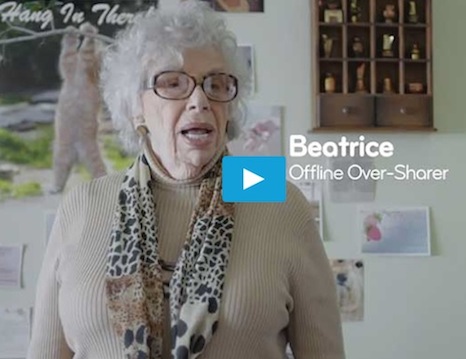Articles and News
Boom! How Not To Lose Your Best Customers | October 15, 2014 (0 comments)

Merrick, NY—In 1996, two seismic demographic events occurred: the first wave of Baby Boomers turned 50, and the first wave of Millennials turned 18. 2011 was another landmark, when the first wave of Boomers turned 65. But perhaps the most overlooked demographic event is occurring even as you are reading this article: the youngest Boomers turn 50 this year. In just 11 weeks, there will be no more Boomers under 50.
But when the last wave of Millennials turns 18 (in approximately four years) it will attract far more marketing dollars than this year’s landmark Boomer birthdays.
What’s wrong with this picture?
It’s a lot of money being ignored, that’s what. 95% of marketing dollars in the United States are spent targeting consumers under 50. But consumers over 50 control about 70% of the wealth in the country and are responsible for 50% of all consumer spending. If Boomer spending power were its own country, it would be the third-largest economy in the world. Only the gross national products of the United States and China represent more money than the Boomers’ collective spending power, says Robert Love, editor-in-chief of AARP magazine. Yet only 5% of total marketing dollars are targeted toward them. If an alien landed on Earth with no knowledge of the Boomer generation apart from the ads targeted to it, they might well envision a group of people with chronic acid reflux worrying about retirement savings and Viagra.
Millennials are undoubtedly the future—and of course any business that wants to live on into the future needs them—but experts warn retailers not to let a focus on Millennials come at the expense of neglecting Boomer spending power now.
Just as Boomers redefined marketing once (who was responsible for youth culture in the first place?) they now are redefining older consumers. Between advances in medicine and better fitness and education, middle age has been extended far into what would previously have been considered old age. Today’s 65-year-old bears little resemblance to their grandparents, whether in looks, activities, health, or spending. They dress like Michelle Obama, not like Beatrice in the Esurance commercial.
Marketers that ignore Boomers do so at their own peril. For example, veteran advertising executive Bob Hoffman recently pointed out despite youth-centric automotive advertising, people between the ages of 75 and dead bought five times as many new cars as people between the ages of 18 and 34. Boom!

Boomers in their golden years still are more inclined to dress and act like Michelle Obama, above, than Beatrice of Esurance fame, below.
In its Tuesday Tips & Tricks newsletter, Fruchtman Marketing recently featured an article titled “60 is the new 50.” In it, the agency pointed out that mid- and late-life divorces are rocketing, while over-50 is the fastest growing segment of users for online dating sites. This offers opportunity for jewelers to not only sell (bigger) engagement rings to second- and third-time couples, but also to sell a host of non-bridal jewelry to those Boomers who choose to remain comfortably single and indulge themselves.
Our own aging industry. Jewelry industry leaders have been worried about the demographics of our own industry. We certainly know how to sell to Boomers, being as how a huge percentage of the industry falls into that category. But long term, we do need the Millennials, and experts have been concerned about how the over-50 set can maintain its relevance with younger consumers without losing touch with the loyal customers now.
It’s not as much of a worry as it used to be. “It depends on where you are and who you hang around with,” says Doug Hucker, CEO of the American Gem Trade Association. Years ago, Hucker was one of the first to point out that the jewelry industry needed an infusion of younger blood, as few people in leadership positions were under 50; even fewer were under 40, and forget under 30.
Today, however, he feels reassured that there is new blood coming into the industry, even if it’s not always visible from the top.
“When you’re at a show or an event, we tend to hobnob with the owners and principles, because they are the people who go to shows and events—and they tend to be older. But I recently went to [GIA] Career Fair and I saw lots of younger people interested in getting into the industry.
“The business is morphing into something that is pleasing to Millennials. The more the industry focuses on corporate social responsibility, the more we appeal to Millennials.”
Then, too, part of the appeal of the jewelry industry is that there is opportunity, period.
“It’s been hard to attract young people to a business like ours with lots of hard work that isn’t all sexy,” says Hucker. “We’ve done a good job of making it sexier—but there also are fewer options than there used to be. The jobs in other fields just aren’t there,” he says bluntly.
GIA graduates have vocational training for real jobs the industry has to offer, he says. And Millennials also are reaching a point in maturity where they realize they have to work hard and earn their way up.
“Boomers have made it easy on their kids, but they’re now realizing it’s not all going to come so easy. They may be attracted to the idea of traveling but they’re now mature enough to realize they have to put in the time and effort to work their way up. They’re not going to begin their career by traveling the world as a gem buyer.”
The Diamond Council of America also is working on a jobs program for the next generation. Its new Jewelry Career Readiness program, which debuted last year, offers DCA courses to high school students through their school district. Once a district joins the program, it is open to as many of its students as wish to enroll. Students who complete the program are added to DCA’s database on an opt-in basis, which can aid in a job search in the jewelry industry.
“The kids started out polite, but not really buzzed,” says Terry Chandler, DCA's CEO. But by the time they earned their DCA certificates, however, they were ecstatic about jewelry and the fact that they could get a job in a jewelry store during college, instead of waiting tables.
“It totally broke down the barrier of the jewelry store door,” says Chandler. He and Hucker both agree that even if the kids who are attracted to the industry through programs like Career Fair or the DCA program don’t buy jewelry now, it is turning them into jewelry lovers.
“Millennials want to adorn themselves, to set themselves apart. If they learn about jewelry and gems, they’ll want to wear them. Even if they don’t end up working in the jewelry industry, they will end up buying gems once they know about them. We just have to make those pieces [of jewelry] appealing,” he says.
“One of the students told me that someday in his life he is going to own a nice tanzanite,” says Chandler.
What about appealing to the group that already has the money—the Boomers? Remember, Boomers want to be youthful, not juvenile. They don’t want to dress like Miley Cyrus, but fashion and style are hugely relevant.
In Part II: How to appeal to both Boomers and Millennials simultaneously.
Top image: the-baby-boomers-webplace.com








